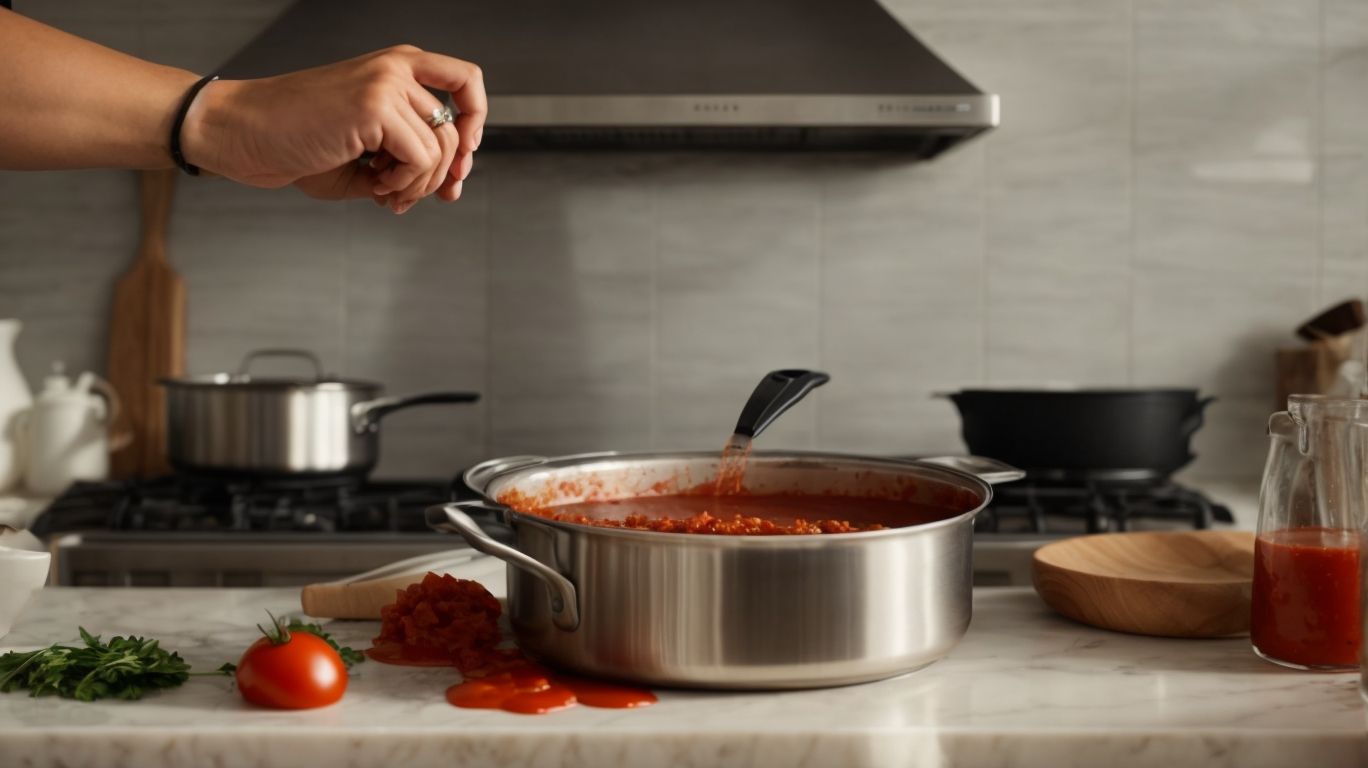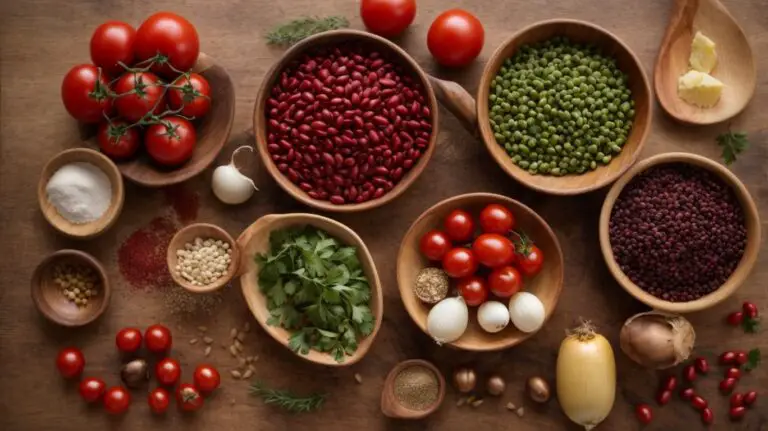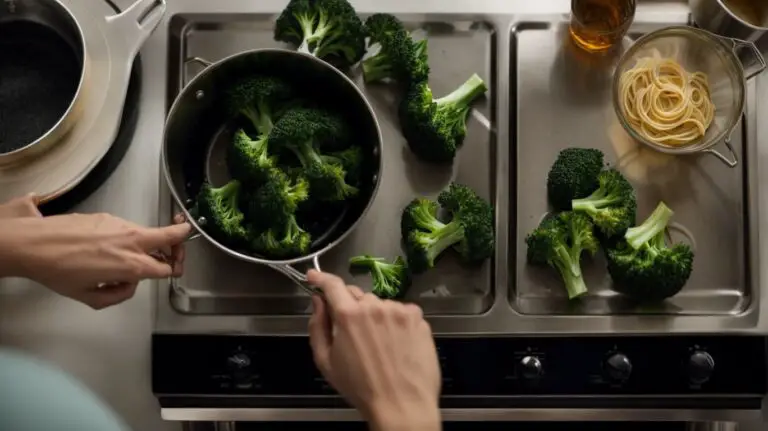How to Cook Sauce for Spaghetti?
Looking to elevate your pasta game with a delicious homemade sauce? This article will share a step-by-step guide on how to cook the perfect sauce for spaghetti. We cover the essential ingredients, preparation techniques, and cooking methods. Join us as we explore culinary delights with Chris Poormet, the award-winning culinary blogger and former chef. Impress your taste buds and guests with this mouthwatering recipe!
Key Takeaways:
About the Author: Chris Poormet
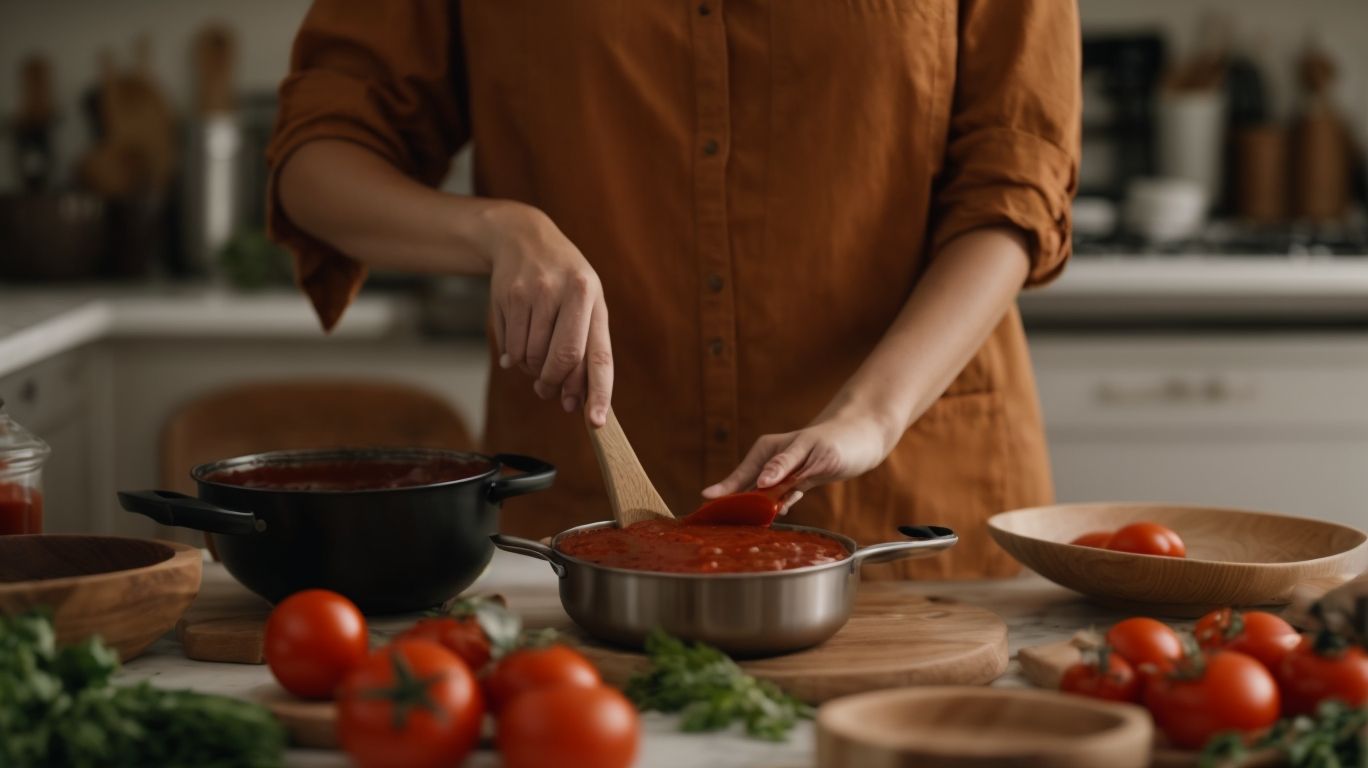
Credits: Poormet.Com – Benjamin Lewis
Chris Poormet, the owner of Poormet.com, is an esteemed culinary blogger who has been recognized as the Culinary Blogger of the Year for his exceptional recipes and food photography skills.
Having honed his craft over the years, Chris has truly made a mark in the culinary world with his innovative dishes and stunning visuals. His journey as a chef began at a young age, inspired by his grandmother’s traditional recipes and the vibrant flavors of his cultural heritage.
Through dedication and a keen eye for detail, Chris has garnered numerous accolades for his unique approach to food photography, capturing the essence of each dish in a way that engages his audience and leaves them craving more.
What Ingredients Do You Need?
Creating a delicious spaghetti sauce requires a blend of fresh ingredients such as tomatoes, onions, garlic, San Marzano tomatoes, ground beef, herbs like basil and parsley, and a mix of seasonings to infuse rich flavor into the homemade sauce.
When selecting San Marzano tomatoes, opt for canned ones as they provide a deep, sweet flavor that is perfect for sauces. Ground beef adds a savory depth to the sauce, enhancing its overall taste and texture. It’s crucial to finely chop onions and garlic to release their aromatic flavors and create a robust base for the sauce.
Incorporating a variety of seasonings like oregano, thyme, and a pinch of red pepper flakes brings a delightful complexity to the sauce. The fresh herbs, such as basil and parsley, add a vibrant freshness that elevates the overall profile of the dish.
Tomatoes
Tomatoes, especially San Marzano variety, form the base of a delicious spaghetti sauce, providing a burst of fresh flavor that enhances the overall taste of the dish.
Choosing high-quality tomatoes is crucial in creating a rich and flavorful spaghetti sauce. San Marzano tomatoes, specifically grown in the rich volcanic soil of the Sarno River valley in Italy, are known for their intense sweetness and low acidity. These characteristics make them ideal for sauces, as they bring a natural sweetness that balances acidity, resulting in a well-rounded taste.
When you use San Marzano tomatoes, their dense flesh and fewer seeds contribute to a thicker consistency, perfect for that classic, hearty sauce texture. This variety is also prized for its vibrant red color, which not only makes the sauce visually appealing but also indicates a high lycopene content – a powerful antioxidant that is beneficial for health.
Onions
Onions and garlic play a crucial role in adding depth of flavor and aromatic richness to the spaghetti sauce when sautéed to perfection, creating a savory base for the dish.
When onions are cooked slowly over low heat, they release their natural sweetness, balancing the acidity of tomatoes in the sauce. Similarly, garlic, when sautéed until golden brown, develops a nutty flavor that enhances the overall taste profile.
This flavor foundation is essential in Italian cuisine, where the marriage of these two ingredients forms the heart of many traditional dishes. The gentle sautéing process not only softens the onions and garlic but also allows their flavors to marry with other ingredients, resulting in a harmonious blend that elevates the entire dish.
Garlic
Garlic, with its pungent aroma and distinctive flavor, adds depth and complexity to the spaghetti sauce when sautéed to release its robust essence, elevating the overall taste of the dish.
By infusing the sauce with garlic’s intense aroma, you create a rich foundation filled with savory notes that enhance each bite of the pasta. The process of sautéing garlic plays a crucial role in extracting its flavors without burning, ensuring a delicate balance of sweetness and earthiness. This culinary technique allows the garlic to mellow and meld with other ingredients, creating a harmonious symphony of tastes. The aromatic allure of garlic as it sizzles in olive oil not only tantalizes the senses but also establishes a complex base for the sauce.
Olive Oil
Olive oil, a staple in Italian cuisine, is essential for sautéing onions, garlic, and other ingredients to build the foundation of a rich and flavorful spaghetti sauce.
As the base of many Italian dishes, olive oil not only acts as a medium for cooking but also plays a crucial role in enhancing the overall taste profile of the sauce. The art of using olive oil in cooking is deeply embedded in traditional Italian culinary practices, where the quality and type of olive oil used can significantly impact the final flavor of the dish.
When sautéing the aromatics in olive oil, it helps release their natural oils and intensifies their flavors, resulting in a luscious and aromatic base for the spaghetti sauce. This process allows the onions and garlic to caramelize gently, adding complexity and depth to the sauce.
Herbs and Spices
Incorporating a blend of herbs and spices such as basil, parsley, and oregano adds aromatic depth and flavorful complexity to the spaghetti sauce, creating a harmonious balance of seasonings.
The fresh, earthy flavor of basil brings a hint of sweetness to the sauce, complementing the tangy tomatoes perfectly. While parsley, with its grassy notes, adds a refreshing undertone that brightens the overall taste profile.
Oregano, on the other hand, infuses a robust, peppery essence, elevating the dish with its warm and slightly bitter undertones. When combined, these herbs not only enhance the aroma of the sauce but also contribute to a rich, multidimensional flavor that is bound to tantalize your taste buds.
How to Prepare the Ingredients?
Before embarking on making the spaghetti sauce, it is essential to prepare the ingredients meticulously by blanching the tomatoes, finely chopping the onions and garlic, and prepping the herbs and spices to ensure a seamless cooking process.
Start by blanching the tomatoes – this process involves immersing them in boiling water for a few minutes, then plunging them into ice water to make peeling easier. Once peeled, remove the seeds and dice the tomatoes.
Next, finely chop the onions and garlic, ensuring they are cut evenly to enhance flavor distribution in the sauce. Sautéing these aromatic ingredients will create a flavorful base for your sauce.
Don’t forget to gather your herbs and spices – commonly used options include basil, oregano, bay leaves, and a pinch of red pepper flakes for a subtle kick.
Blanching Tomatoes
Blanching tomatoes involves a quick cooking and peeling process that helps in removing the skin easily, allowing for a smoother texture and enhanced flavor in the spaghetti sauce.
When blanching tomatoes for your pasta sauce, start by boiling a pot of water. Make a small cross-cut at the bottom of each tomato with a knife and gently drop them into the boiling water.
Let them blanch for about 30-60 seconds until you notice the skin starting to peel away. Quickly transfer the tomatoes to a bowl of ice water to stop the cooking process.
Peeling the tomatoes will now be a breeze as the blanching has loosened the skin, revealing the juicy flesh within.
Chopping Onions and Garlic
Properly chopping onions and garlic, whether minced or diced, is crucial for efficient sautéing and flavor development in the spaghetti sauce, ensuring a balanced distribution of aromatics throughout the dish.
Regarding mincing garlic, start by peeling the cloves and then finely slicing them lengthwise. Next, make horizontal cuts and finally chop them into tiny pieces. This method releases the essential oils, intensifying the garlic’s flavor without overwhelming the sauce.
On the other hand, for onions, cut off the ends, peel off the skin, and halve them vertically. With the flat sides down, make vertical cuts without slicing all the way through, then proceed with horizontal cuts. This way, you achieve finely diced onions that blend seamlessly into the sauce.
Preparing Herbs and Spices
Preparing herbs and spices involves blending a variety of seasonings like basil, parsley, and oregano to create a flavorful seasoning mix that enhances the aroma and taste of the spaghetti sauce.
When starting the process, gather fresh basil, parsley, and oregano. Ensure the herbs are washed and dried thoroughly to preserve their flavors. Chop the basil finely for a delicate touch, while the parsley can be roughly chopped for added texture. Oregano, with its earthy flavor, should be crushed gently to release its aromatic oils.
- Next, mix the herbs in a bowl, adjusting the ratios to suit your taste preferences. A common blend includes equal parts basil and parsley, with a hint of oregano for depth.
- Consider adding a touch of garlic powder or red pepper flakes for a spicy kick, or a pinch of sugar to balance out the acidity of the tomatoes in the sauce.
How to Make the Sauce?
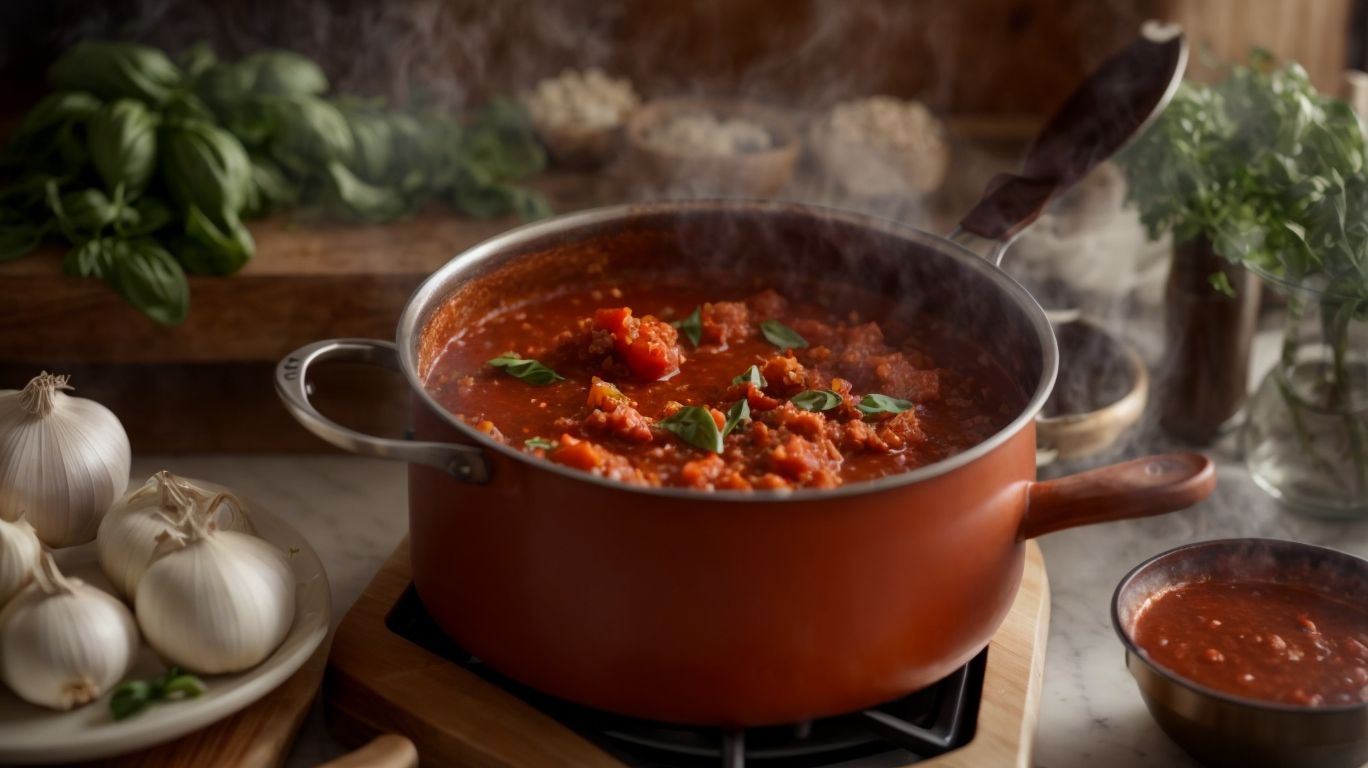
Credits: Poormet.Com – Alan Mitchell
Crafting a delectable spaghetti sauce involves a series of steps, including sautéing onions and garlic, adding a blend of tomatoes and herbs, and simmering the sauce to perfection to develop a robust flavor profile.
Once the onions and garlic have been sautéed to a golden brown, tomatoes come into play. Whether using fresh, canned, or pureed tomatoes, their incorporation is crucial.
The tomatoes infuse the sauce with a rich, tangy base, complementing the savory notes of the sautéed onions and garlic perfectly. Selecting ripe, high-quality tomatoes enhances the overall taste of the sauce.
After adding the tomatoes, a medley of herbs is sprinkled in. Basil, oregano, and thyme bring a fragrant dimension to the sauce, creating a harmonious blend of flavors.
The final step involves simmering the sauce on low heat, allowing all the ingredients to meld together, intensifying the taste and aroma.
Sautéing Onions and Garlic
The initial step in making the spaghetti sauce involves sautéing onions and garlic in olive oil until they turn golden brown, releasing a tantalizing aroma that forms the base of the sauce’s flavor profile.
As the onions and garlic gently cook in the heated olive oil, their natural sugars caramelize, bringing out a sweet and savory depth to the sauce. This process not only adds a rich flavor but also creates a fragrant foundation that permeates the entire dish. Achieving the perfect golden brown hue is crucial here, as it indicates that the onions and garlic have developed their full flavor potential.
The sizzling sound and enticing aroma are signs that the Maillard reaction is at work, enhancing the complexity of taste in the sauce. The marriage of these two ingredients with the olive oil forms a holy trinity that sets the stage for a delicious and well-rounded spaghetti sauce.
Adding Tomatoes and Herbs
Incorporating a mix of tomatoes and herbs into the sautéed onions and garlic sets the foundation for the spaghetti sauce, allowing the flavors to meld together through gentle simmering and infusion.
After adding the tomatoes and herbs to the fragrant mixture, the next crucial step is to allow the sauce to simmer on low heat. This process is essential as it gives the ingredients time to release their flavors and harmonize with one another. Simmering for around 20-30 minutes helps the sauce develop its rich taste and aroma, intensifying the overall dish. Remember, patience is key at this stage; the longer the sauce simmers, the more robust and flavorful it becomes.
Simmering the Sauce
Simmering the spaghetti sauce over low heat allows the flavors to intensify, the liquid to reduce, and the sauce to develop a deep, rich taste that encapsulates the essence of a well-crafted dish.
This slow cooking process enables the ingredients to meld together harmoniously, creating a symphony of flavors that dance on your taste buds. As the sauce simmers, the water content evaporates gradually, leading to a more concentrated taste profile. Simmering helps to soften any tough ingredients, such as onions or garlic, allowing them to infuse their essence into the sauce seamlessly. The key is to maintain a gentle simmer without boiling, which ensures that the sauce thickens gradually and the flavors blend beautifully.
How to Cook the Spaghetti?
Cooking perfect spaghetti involves precise steps, starting with boiling water, adding salt and pasta to achieve the desired texture, and finally draining and tossing the pasta to ensure even coating with the delectable sauce.
Fill a large pot with water, allowing at least 4-6 quarts of water per pound of pasta. It’s crucial to bring the water to a rapid boil over high heat before adding a generous amount of salt. The water should taste almost like seawater to properly flavor the pasta.
Once the water is vigorously boiling and seasoned, gently drop the spaghetti into the pot. Stir the pasta immediately to prevent sticking and cook it according to the instructions on the package for the perfect al dente texture.
Boiling Water
The first step in cooking spaghetti involves bringing water to a rolling boil, which is essential for achieving the ideal texture and consistency of the pasta, ensuring it cooks to perfection.
Boiling water may seem straightforward, but it plays a vital role in pasta preparation. To start, select a large pot, ensuring there is enough room for the spaghetti to move freely and cook evenly. Fill the pot with fresh, cold water, as using hot water from the tap can contain impurities affecting the taste. Sprinkle a pinch of salt into the water to enhance the pasta’s flavor.
Place the pot on the stove over high heat and cover it with a lid to accelerate the boiling process. The lid helps trap the heat, reducing the time it takes for the water to reach a rolling boil. Patience is key, as the water needs to bubble vigorously before adding the pasta.
Adding Salt and Pasta
Adding salt to the boiling water and gently introducing the pasta sets the stage for achieving the desired al dente texture, ensuring proper seasoning and enhancing the overall taste of the dish.
When you add salt to the boiling water, it not only flavors the pasta from within but also helps to elevate the taste of the entire dish. Salt plays a crucial role in enhancing flavors and balancing out the natural sweetness of the pasta.
By cooking the pasta to the al dente texture, you ensure that it maintains a slight firmness in the center, offering a satisfying bite. This perfect texture can be achieved by following the recommended cooking time on the pasta package and occasionally tasting to check for readiness.
Draining and Tossing the Pasta
Draining the cooked pasta and tossing it gently with the prepared sauce ensures even coating, allowing the flavors to meld together seamlessly and creating a harmonious blend of pasta and sauce.
When draining the pasta, remember it’s best to leave it slightly damp as the residual water can help the sauce adhere better. Once you’ve combined the pasta and sauce, consider letting them sit together for a few moments to truly absorb the flavors. To achieve a restaurant-quality dish, use the Italian technique of adding a splash of the pasta cooking water to the sauce; this starchy water helps bind the sauce and pasta, enhancing the overall consistency. Tossing the pasta and sauce vigorously ensures each strand is coated and infused with the flavorful sauce. The key is achieving a perfect balance between pasta and sauce, neither drowning the pasta nor leaving it dry.
How to Serve and Store the Sauce and Spaghetti?
After preparing the delectable spaghetti sauce and pasta, ensure to serve the dish hot and fresh, while any leftovers can be stored in refrigerator or freezer-safe containers for reheating later, allowing the flavors to develop further over time.
When you’re ready to reheat the leftover spaghetti, consider using a microwave-safe dish or saucepan on the stovetop. Make sure to add a splash of water or broth to prevent the pasta from drying out during reheating. By gently simmering the spaghetti, you can help revive the flavors and retain the dish’s original texture.
For optimal results, allow the leftover spaghetti to thaw in the refrigerator overnight before reheating. This gradual thawing process can prevent the pasta from becoming mushy when reheated.
Using airtight containers or resealable bags for storage can help preserve the spaghetti’s freshness and prevent any odors from seeping into the dish. When storing in the freezer, remember to leave some room at the top of the container to allow for expansion as the spaghetti freezes.
Frequently Asked Questions
How to Cook Sauce for Spaghetti?
To cook a delicious sauce for spaghetti, start by heating olive oil in a pan and sautéing onions and garlic. Then, add your choice of tomatoes (diced, crushed, or pureed) and seasonings. Let it simmer for 20-30 minutes before serving over cooked spaghetti.
Can I use canned tomatoes for my spaghetti sauce?
Absolutely! Canned tomatoes are a great option for making spaghetti sauce. Just make sure to drain any excess liquid before adding them to the pan.
How can I make my spaghetti sauce thicker?
If you prefer a thicker consistency for your sauce, you can add tomato paste or simmer it for a longer period of time. Another option is to blend in some cooked vegetables or use a thickening agent like cornstarch.
What seasonings should I use for my spaghetti sauce?
This is a matter of personal preference, but some common seasonings for spaghetti sauce include oregano, basil, garlic powder, onion powder, and red pepper flakes. You can also add fresh herbs like parsley or thyme for extra flavor.
Can I freeze leftover spaghetti sauce?
Yes, you can freeze spaghetti sauce for future use. Let it cool completely before transferring it to an airtight container or freezer bag. It can be stored in the freezer for up to 3 months.
How do I reheat frozen spaghetti sauce?
The best way to reheat frozen spaghetti sauce is to thaw it overnight in the refrigerator and then heat it up on the stove or in the microwave. You can also add a little water or broth to thin it out if needed.

